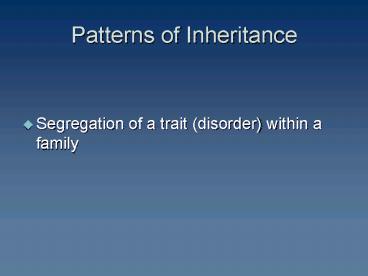Patterns of Inheritance PowerPoint PPT Presentation
1 / 33
Title: Patterns of Inheritance
1
Patterns of Inheritance
- Segregation of a trait (disorder) within a family
2
Modes of Inheritance
- Mendelian Inheritance
- - autosomal recessive
- - autosomal dominant
- - X-linked recessive
- - X-linked dominant
- Non-Mendelian inheritance
- - mitochondrial inheritance
- - imprinting
- - uniparental disomy
- - triplet repeat expansion/
anticipation - - digenic inheritance
3
Modes of Inheritance (cont.)
- Chromosomal disorders
- - caused by alterations in number, or
structure of chromosomes - Multifactorial disorders
- - determined by one or more genes, as well
as environmental factors
4
(No Transcript)
5
Definitions
- Genetic locus specific position of each gene on
the chromosomes - allele(s) alternate forms of genes
- i) may be variations of
normal - e.g., blood group alleles
- ii) may result in a medical
disorder - e.g., cystic fibrosis,
hemophilia, Marfan disease
6
Definitions (cont.)
- homozygous both alleles the same dd, DD
- heterozygous alleles are different Dd
- hemizygous only one copy (genes on the X
chromosome in males) - trait observed expression of
the gene
7
Definitions (cont.)
- Genotype genetic constitution (at one or all
loci) - Phenotype observed expression of a genotype
- (depends on how you define the trait -- at
the morphological, cellular, or biochemical
level)
8
HETEROGENEITY
- Genetic heterogeneity (locus heterogeneity)
- - mutations of different genes causing the same
disease - Clinical heterogeneity (allelic heterogeneity)
- - mutations of the same gene causing different
diseases
9
MENDELIAN INHERITANCE
- Single gene disorders (Mendelian disorders) are
due to mutations in one or both members of a pair
of autosomal genes, or to mutations on the X or Y
chromosomes
10
(No Transcript)
11
Mendelian Inheritance
- Dominant inheritance
- - When the trait (disorder) is expressed in the
heterozygote (Dd) - Recessive inheritance
- - When the trait is only expressed in the
homozygote (dd) - autosomal inheritance
- - Genes on chromosomes 1-22
- X-linked (sex-linked) inheritance
- - Genes on the X (or Y) chromosomes
12
- You determine the inheritance pattern by
observing the segregation of the trait within
families - -- must obtain a family history
- (usually diagrammed in a pedigree)
13
(No Transcript)
14
(No Transcript)
15
(No Transcript)
16
Autosomal dominant inheritance
- - both males and females affected
- - persons affected in each generation
(vertical inheritance pattern) - - every affected person has an affected parent
- - offspring of an affected person have a 50
risk of being affected - - unaffected persons do not transmit the
condition - - males can transmit the condition to males and
females (and vice versa)
17
(No Transcript)
18
(No Transcript)
19
(No Transcript)
20
Exceptions
- Variable expression
- Reduced penetrance / non-penetrance
- New mutations
21
(No Transcript)
22
HNPCC (hereditary non-polyposis colon cancer)
- 5-10 of all colorectal cancer
- predisposition to colon and extra-colonic cancers
(e.g. endometrial, ovarian, stomach, urogenital
ca) - variable age at onset (20s 70s)
- due to mutations in mismatch repair genes (MSH2,
MLH1, MSH6 etc)
23
HNPCC screening protocol
- colonoscopy every 1-2 yrs from mid-twenties
- annual pelvic exam, endometrial biopsy,
transvaginal US, CA125 testing - upper GI endoscopy every 3 yrs
- (subtotal colectomy rather than partial
colectomy if surgery required)
24
(No Transcript)
25
(No Transcript)
26
(No Transcript)
27
- RULES -- Every affected person has an
affected parent - -- Unaffected persons do not transmit
the condition - EXCEPTION Affected person with normal parent
- Possible explanations
- Parents died young/never examined
- No medical information available
- Variable expressivity (different expression that
is not - recognized)
- Variable age at onset
- Non-penetrance ( penetrance
expressing trait -
with mutation ) - New mutation
28
(No Transcript)
29
(No Transcript)
30
Hereditary Breast Cancer
- 5-10 of all breast cancer
- variable expressivity
- -predisposition to breast /or ovarian ca
(/- male breast ca, prostate, colon,
pancreatic ca, etc) - variable age at onset
- two genes known
- -BRCA1 chr17
- -BRCA2 chr13
31
Screening Protocol
- self-breast examination
- clinical breast exam (every 6-12 mos)
- annual mammograms from age 25-30
- pelvic exam, transvaginal US
- CA125 testing
32
Types of dominant mutations
- reduced gene function (haplo-insufficiency)
- increased or constitutive gene function
- (e.g. in regulatory genes)
- dominant negative gene product that interferes
with the normal allele - altered structural protein (e.g. collagen /
fibrillin) - Recessive mutations - often defective enzymes
33
(No Transcript)

